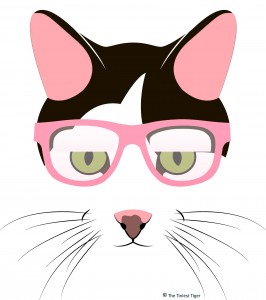Cat Anatomy
Our friends at pet365.co.uk asked me if I would be interested in sharing this fun Cat Anatomy graphic with you. I thought you might like the graphic too and that we could chat for a moment about one of the fun facts.
The graphic says the cat has the largest eyes of any mammal. I think we need to add in proportion to their body size because whales are mammals too and a whale’s eye can be the size of an orange or a soccer ball depending upon the species. But in proportion to body size, we felines have the largest eyes.
My What Big Eyes You Have
Our cat eyes give us an unfair advantage when it come to controlling humans with our cuteness. Most humans are

This is Thinking Gracey. When you see this image, you might want a “thinking beverage” and/or a nap.
captured by cat cuteness because of our forward facing eyes, our roundish shaped faces and let’s not forget our cute button noses. Humans are helpless really, because this is hard wired into them by evolution.
Human baby heads are round because their brains continue to grow throughout the first months of life, and the plates of the skull stay flexible to accommodate the development. A human baby’s eyes and ears are situated comparatively far down the face, are forward facing and they have a cute button nose in between. But scientists know babies did not evolve to be cute, but that the human brain evolved to find the big eyed babies appealing. Being irresistible in the eyes of their caretakers helped to ensure the helpless baby’s survival.
The Cute Factor
Marketers know this too, because even cartoon character mice and ducks have forward facing eyes, when the real mice and ducks have eyes on the side of their heads. But cats, cartoon and real, have forward facing big eyes with adorable ears and whiskers too. So humans can’t help themselves when they squeal at cat cuteness and sometimes kiss us uncontrollably. ~sigh~ You see, researchers know that animals most beloved by the general public are those that might even remotely resemble human baby like features! And, it doesn’t just need to be appearance but can be behavior too. For example, a penguin waddling might trigger a human to think about a baby learning to walk with a side to side gait as the child struggles to keep balance.
Cuteness is primal and present in all cultures and can be compared to the humans love for the taste of sugar. All humans have sweetness receptors on their tongues, but some people eat a lot more sweet foods and drinks than others. (By the way, we cats have evolved to not be able to taste sweet. You can read more about that in my post Cat Menu Leaves No Room for Dessert.)
Kawaii! The Japanese are keen on cute!
Kawaii (???? [kaw?ai.i], means, “lovable”, “cute”, or “adorable”) is the quality of cuteness in the context of Japanese culture.
Studies show that the Japanese are quite keen on cute, or kawaii as it is known in Japanese where even men are known to sport Hello Kitty figurines on the dashboards of their vehicles. According to Brian J. McVeigh, an East Asian scholar, kawaii is a phenomenon because of the strong hierarchical nature of the Japanese culture. McVeigh says that “Cuteness is used to soften up the power relations and present authority without being threatening.”
Humans should proceed directly to the graphic below.
For Cat Eyes Only!
And isn’t that exactly what we cats do to our parents? Our cuteness takes our parents off guard and without even knowing it, they are catering to our every whim and fancy, even enjoying their role as our caretakers. They go about their lives under our top predator power without feeling threatened or realizing they are being controlled by our cuteness.
Thanks so much for sharing this – glad you liked it… and you’re right about needing to add in the ‘proportion’ note. If I get chance I’ll update the wording 😉 -Matt (from Pet365).